My mother’s been holding out on me. For many years, she’s maintained that she’s really not interested in family history. And I can accept that. Although it’s difficult for me to empathize, I do understand intellectually that there are some people who just aren’t enthralled at the prospect of digging up documents pertaining to long-gone generations of the family, and Mom is one of those people. However, while helping to sort and reorganize accumulated papers in her desk recently, I discovered a folder, neatly marked “Genealogy Information.” What?! Curiosity piqued, I sifted through the contents of the folder, and discovered that most of it was merely stuff I’d given to her over the years, hard copies of emails I’d written to my parents as I made new family history discoveries. However, some of it was pure genealogical gold, including a bridal picture of my great-grandaunt, Wanda, an envelope of prayer cards from family funerals, and—best of all—a letter written by my grandmother, Helen Zielinski, in 1977.
The letter was addressed to my parents, my sister, and me. At that time, my family was living in Cincinnati, Ohio, while Grandma and Grandpa still lived in North Tonawanda, New York. The letter was dated 4 December, and the first page is delightfully chatty. Grandma noted that she’d call on Friday, thanked Mom for some photos Mom recently sent, expressed concern that my other Grandma, Marie Roberts, had been in the hospital, and offered to send Christmas cookies in case my mother did not have time to bake. The next pages, however, are even better: Grandma provided brief biographical information about each of her parents and Grandpa’s parents, as well as some other interesting tidbits of family history.
This part of the letter was written in order to help my sister with a family history project she was doing in school. At that time, my sister was in 4th grade and I was in 3rd grade, and she was working on a “Roots” project, which (sadly) I was not also required to do when I got to 4th grade. The project was aimed at helping the students discover their family history, so it was necessary for them to interview their elders and ask about previous generations of the family, as well as any family traditions or ethnic customs that were still practiced. I remember when this project was taking place, and I knew that Grandma had contributed a great deal of information. It made sense that Mom would have saved this letter; however, I’d never actually seen it or read it previously.
It’s clear that Grandma really enjoyed helping with the project, and she wrote about how she spoke with two of her cousins, Carrie Baginski and Arthur Gray, to help her fill in the blanks. It was really fascinating for me to read this information, recorded in Grandma’s own handwriting. It was especially interesting to see how this information measured up against the documentary paper trail that I’ve been gathering over the years since then. Here, then, is Grandma’s original information, recalled and recorded by her at the age of 57, in collaboration with information from some of her cousins, compared with “the rest of the story.”
On Joseph Zielinski (My Great-Grandfather):
Starting off with her father-in-law, Joseph Zielinski, Grandma wrote, “Born in Poland in 1892—lived with his parents on a farm in a village called ‘Sochaczew’ near Warsaw. He arrived in New York City in 1914. He left Poland because he would have had to serve in the Russian Army. Joseph had one brother named Frank who was killed in World War II in America. Joseph died at age 80 in August 1973.”[1]
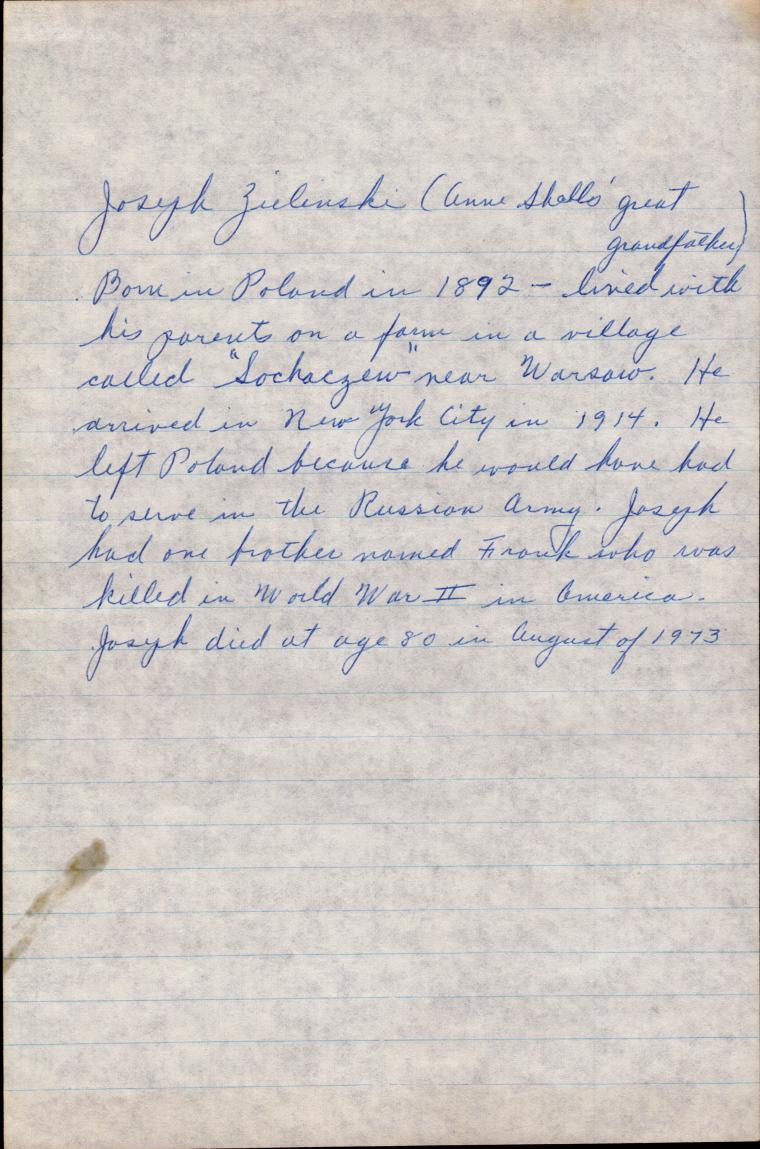
Analysis: Grandma was spot-on about Joseph’s birth year in 1892, in spite of census records, a World War II draft registration, and the record from his second marriage, which would all argue that Joseph was born between 1893-1894. Joseph’s birth record confirms that he was born 10 October 1892; however, he was born in the village of Mistrzewice, not in the town of Sochaczew. Mistrzewice is located in Sochaczew County, and the Zieliński family’s deeper roots lie in the parish of Sochaczew itself, since Joseph’s grandfather, Michał Archanioł Zieliński, was born in the village of Bibiampol and baptized in Sochaczew. Therefore it’s actually true, in one sense, that the Zieliński family was “from” Sochaczew, although it would have been more accurate (and would have saved me some time in searching!) if the family history had mentioned Mistrzewice as their more recent place of origin.
It may very well be that Joseph left Poland so he would not have to join the Russian army. Exactly how he managed to avoid the conscription that was mandatory in Russia at that time is unclear, but his World War I draft registration does not indicate any prior service in the Russian army. In contrast, the World War I draft card for Joseph’s brother, Frank, states that he served three years in the Russian infantry. Taken together, these facts seem to confirm the family story that Joseph was able to slip out of the Russian Empire before they could force him into service. It’s also true that Joseph’s brother, Frank, was killed in the war. However, he was killed in World War I, not II. It seems likely that Grandma merely made a recording error when she wrote that Frank was killed in World War II, since the oral family tradition always referenced World War I.
Grandma’s wording does not make it clear if she was aware of other siblings that Joseph and Frank might have had, and one might suspect that she would have identified those siblings by name if she could have. I know now that Joseph and Frank had eight additional siblings—five brothers and three sisters. Five of these siblings (three younger brothers and two younger sisters) were still alive when Joseph left Poland for the U.S., and he arrived in 1912—not 1914. All in all, Grandma was pretty accurate in the information she provided.
On Genevieve Zielinski (My Great-Grandmother):
Next, regarding her mother-in-law, Grandma wrote, “Maiden name—Klaus. Born in 1898 in North Tonawanda, N.Y. Married Joseph Zielinski in 1915. They had five children, John (born Oct. 18, 1916), Frank, Helen, Stanley, and Irene. Genevieve died at age 44 in the year 1942.”

Analysis: Grandma was pretty close with Genevieve’s birth year, but Genowefa Klaus was, in fact, born 28 September 1897 in Buffalo, New York, rather than in North Tonawanda. She married Joseph Zielinski on 6 October 1915 at the church of Our Lady of Częstochowa in North Tonawanda, and of course, the names of their children (my grandfather and his siblings) are accurate. She died on 6 May 1942 at the age of 44, so once again, Grandma did pretty well.
On Mary Klaus (My Great-Great-Grandmother):
Things start to get a little bumpy with Grandma’s next report about her husband’s grandmother. Regarding Mary Klaus, Genevieve Zielinski’s mother, Grandma wrote, “Maiden name—Olszanowicz. Arrived in Texas from Poland. She and her husband had eight (in N.T.) children, Anna, Joe, Pauline, Eddy, Genevieve, Walter, Helen and Rudolf. Anna is still alive, living in Chicago. Mary died in N. Tonawanda at age 65.”
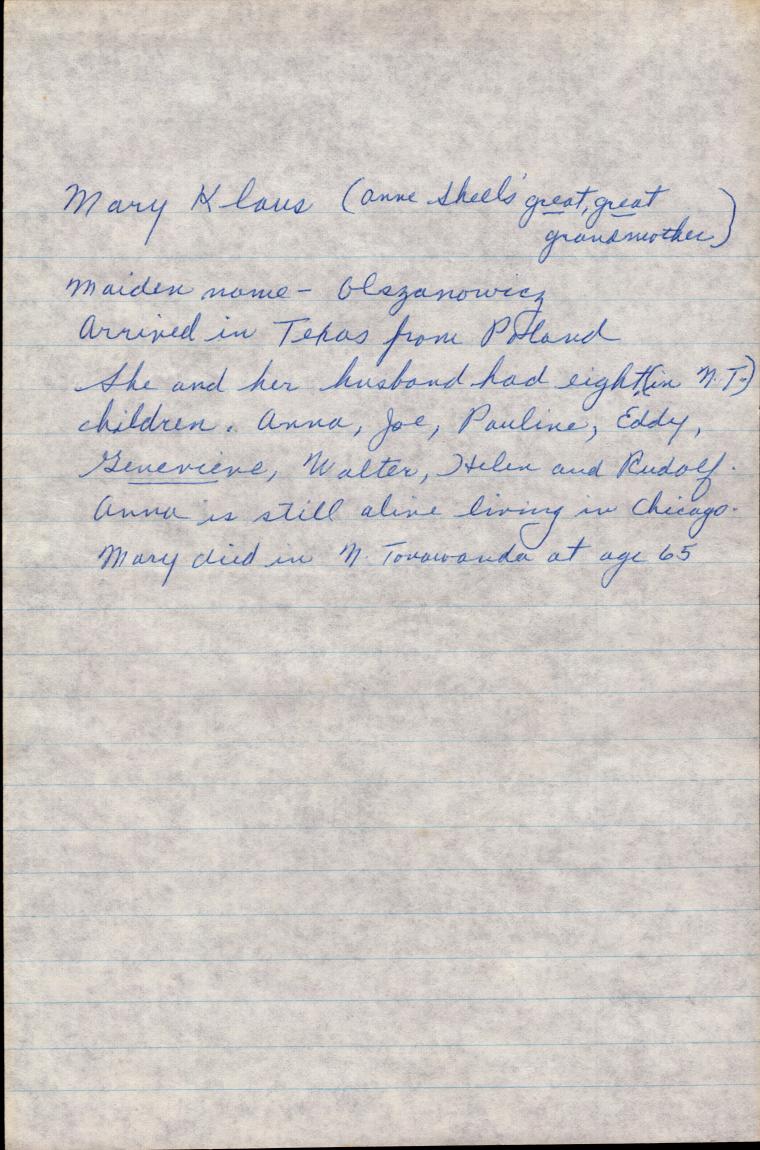
Analysis: Oh, Grandma. Would that I had never heard that story about Texas. I spent so much time trying to find any possible shred of evidence for our family’s sojourn there. And it wasn’t just you, Grandma. Cousin Julia Ziomek reported that same story, in even greater detail. I wrote about it most recently here, but also here, here, and here. The truth, as near as I can figure, is that the entire story was a fabrication created to avoid embarrassing questions about the circumstances surrounding the births of Mary’s two oldest sons, Joseph and John, who were born out of wedlock in Buffalo, New York, prior to Mary’s marriage to her first husband, Andrew Klaus. Mary’s maiden name was not Olszanowicz, either—it was Łącka. Olszanowicz was the name of her second husband, whom she married after Andrew’s death. That marriage did not last long—only three months, reportedly—which may explain why poor Walter Olszanowicz was so easily forgotten, although his name was still recalled in association with Mary. In total, Mary Klaus had 11 children. In addition to Joseph and John, her children with Andrew included Zofia (who died in infancy), Anna, Pauline, Bolesław (who also died in infancy), Genevieve, Edward, Walter, Rudolf, and Helen. Grandma was right, Anna (née Klaus) Gworek Matysak was still alive in 1977 when this letter was written. However, Mary (née Łącka) Klaus Olszanowicz was quite a bit older than most U.S. records would indicate, and she was actually 75, not 65, when she died in 1942.
On John Zazycki (my great-grandfather):
Grandma wrote the following about her father, John Zazycki: “Born in Warsaw, Poland 1866. Came to the United States and went to Alaska to seek employment. While in Poland he served in the Russian Cavalry and got his apprenticeship as a blacksmith. He died in 1924 at age 58. John’s forefathers were named Zazycki because they lived behind a creek. Za—behind, zekom—creek.”
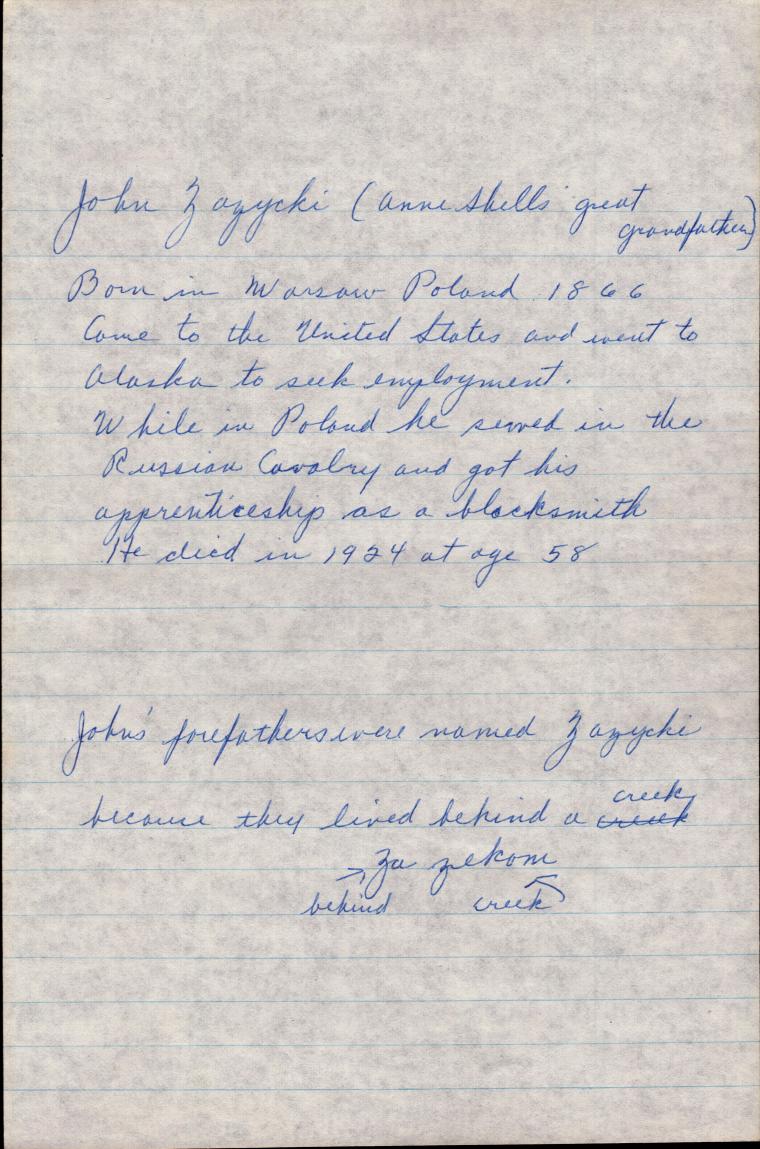
Analysis: As often happened with immigrants, John Zazycki approximated his birthplace to a nearby large city, rather than citing the small village where he was actually born. I now know that John was born 5 March 1866 in the village of Bronisławy, which was located in Sochaczew County in the Warsaw gubernia, or province of the Russian Empire. So in that sense, Grandma’s information that her father was born in Warsaw in 1866 was correct, if not especially precise, since Bronisławy is about 50 miles west of the city of Warsaw. I have not been able to confirm any Russian military service for John, although it’s quite likely that he did serve, since such service was compulsory. Similarly, John died in 1924 at the age of 58, exactly as Grandma reported, and we have documentary evidence that John was apprenticed to a master blacksmith, Józef Gruberski, who was also his brother-in-law. Even Grandma’s Polish surname etymology is approximately correct, although I’ve read that it should be “za rzeka” (“beyond the river”). That leaves the final statement, that John initially went to Alaska to seek employment prior to his arrival in Buffalo, New York.
It turns out that this is a difficult claim to fact-check. John’s naturalization papers state that he arrived in the U.S. on 15 January 1895, and that he resided in the U.S. continuously for 5 years prior to his petition for naturalization in Buffalo on 12 July 1900. Alaska was a U.S. territory, so presumably, John could have traveled to Alaska following his arrival in New York and still count that time toward his 5-year-residency requirement for naturalization. If he did go to Alaska, he was not there for long, and documenting him there, without knowing a specific location, is akin to chasing down my Klaus family in Texas. And we all know how that ended.
On Veronica Zazycki (My Great-Grandmother):
I’ve written previously about some of the interesting statements made by Grandma about her mother, Veronica Zazycki. Grandma wrote, “Maiden name—Grzesiak. Born in the year 1876 in the village ‘Poznan’ near Warsaw. Her parents owned a grain mill. She had a sister Josephine and two brothers—Walter and Thaddeus. They lived near the church and parish house and Veronika’s mother sewed all the vestments for the priest. Veronika’s mother died when Josephine was born so at age 18 she came to America in year 1894. She found employment working in the kitchen of a restaurant. The people could not speak Polish and Veronika could not speak English so they used sign language and called her Mary. She saved her money and sent it to her two brothers so they could come to America. In the meantime, Walter (her brother) married a Polish actress named Wanda and she did not want to leave her career, so he left without her. They say she died of a broken heart.
Veronika married John Zazycki and they had twin boys as their first born, Benjamin and Roman. Wanda was next, then came Leon, Antoinette, Joseph, Angela, and last but not least, their beautiful baby daughter Helen who is sitting here writing ‘Roots.’
Veronika was a seamstress who supported her family after her husband died. She lived to age 62 and was killed in an automobile accident in 1938. Helen’s birthday is Nov. 30th, 1920.”
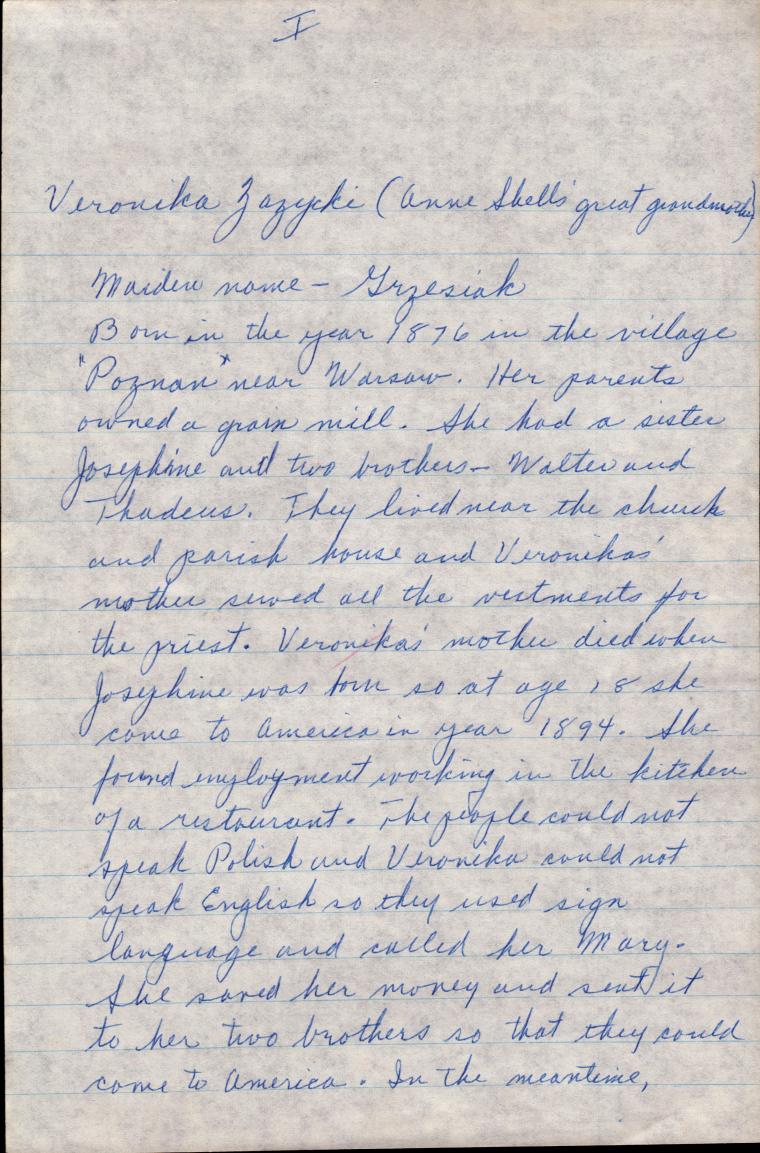

Analysis: Veronica (née Grzesiak) Zazycki was born 27 December 1876 in the village of Kowalewo-Opactwo. The village is about 50 miles east of Poznań, but “Poznań near Warsaw” doesn’t make a lot of sense since Poznań and Warsaw are nearly 200 miles apart. Nonetheless, the reference to Warsaw is interesting in light of the fact that members of the Grzesiak family were living in Warsaw in the years after Veronica moved to the U.S. Her passenger manifest informs us that Veronica arrived in Baltimore in March 1898, and in June 1898, her sister Konstancja married Julian Cieniewski in Warsaw, while her brother Walter married Kazimiera Olczak in Warsaw two months later. These facts underscore two more points—first, that Walter’s wife was not named Wanda, but rather Kazimiera; and second, that Veronica had additional siblings besides Walter, Thaddeus and Josephine. Polish birth records from Kowalewo-Opactwo revealed two more Grzesiak sisters, Pelagia and Konstancja, whose existence was not known to Grandma.
The part about the grain mill, and the proximity of the family home to the church, was something I wrote about in a previous post, as there may be some evidence for that. The part about Veronica’s mother dying when Josephine was born is utterly false, however, as Veronica’s mother, Marianna (née Krawczyńska) Grzesiak, did not die until 1904, several years after most of her children were settled in America. Grandma was a bit off on the timing of Veronica’s immigration, since Veronica did not immigrate in 1894, at the age of 18, but rather in March of 1898, at the age of 21. I have not been able to document the story about Veronica working in the kitchen of a restaurant and being called Mary. However, it always struck me as a bit strange that they would call her Mary when Veronica is a not a name that is unusual or difficult to pronounce in English.
I have a hunch that this part of the story may have something to do with another Mary whom I discovered through my research, Mary Staszak. When Veronica immigrated, her passenger manifest reported that she was headed to her “brother-in-law” in Buffalo, Michael Staszak. Further research revealed that Michael was not Veronica’s brother-in-law at all. Nonetheless, Michael’s wife, Marianna (née Derda) Staszak, was from the same village as Veronica and they traveled together on the ship, although they were recorded on different pages of the ship’s manifest. Research in records from Poland has not revealed any obvious way in which Veronica Grzesiak and Mary Staszak were related. My guess is that they were merely good friends, or at best, distant cousins. But the association between the name Mary, and this story from Veronica’s early days in the U.S., strikes me as something more than coincidental.
The next part about Walter and his actress wife is probably accurate. Walter and Kazimieria (née Olczak) Grzesiak did meet and marry in Warsaw, and I wrote about their story previously. At this point, I think she probably was an actress when they met. However, she did not die of a broken heart, nor did she remain in Poland while Walter came to the U.S. alone. In fact, she came to the U.S. in 1900, along with Walter’s sister, Josephine, and the Grzesiak patriarch himself, Józef, father of Walter, Veronica, Thaddeus and Josephine. Kazimiera was still in Buffalo and married to Walter in 1905 when the New York State census was conducted, but they were separated by 1910, and subsequent newspaper articles from 1912 indicate that Kazimiera had left Walter for another man.
The final part of the story, in which Grandma recounts her siblings’ names is, of course, accurate. However, Grandma’s mother died in 1940, not 1938, at the age of 63. The last line is also interesting to me. Grandma’s birth date of record was, indeed, 30 November 1920. However, we always “knew” her birthday was November 25th, and that’s the day we celebrated it. The story was that Grandma was born on Thanksgiving Day, so the registry office was closed. The midwife could not get in to report the birth immediately, and there were penalties for delays in reporting. So, when she finally visited the office on the 30th to report Grandma’s birth, she simply told them that the baby had been born that day. A quick check of a 1920 calendar confirms that Thanksgiving fell on 25 November that year, so I believe that this story is accurate, although I have no way of proving it to be so.
The last page of the letter includes some miscellaneous information about the family. Grandma wrote, “Genevieve Zielinski embroidered the picture in 1940 and gave it to Helen and John in 1941 when we got married. Dad thinks that the name Zielinski was given to the people because they came from Green County. Green is ‘Zielone,’ County would be ‘Miasto.’ Don’t know of any living relatives. I am giving you all the information I could gather after 7 phone calls on Friday. Seems like names and dates were not important. I am happy to give my Granddaughters the enclosed pictures. Perhaps you would want to mention the fact that Daddy’s parents plus John, Frank and Helen went for a visit to Poland in 1921 and stayed for 3 months.”

The picture that Grandma referenced (below) is now a cherished family heirloom, of course, belonging to my mother. When Grandma Genevieve stitched that picture in the year before she died, she was a patient in the sanatorium, suffering from tuberculosis.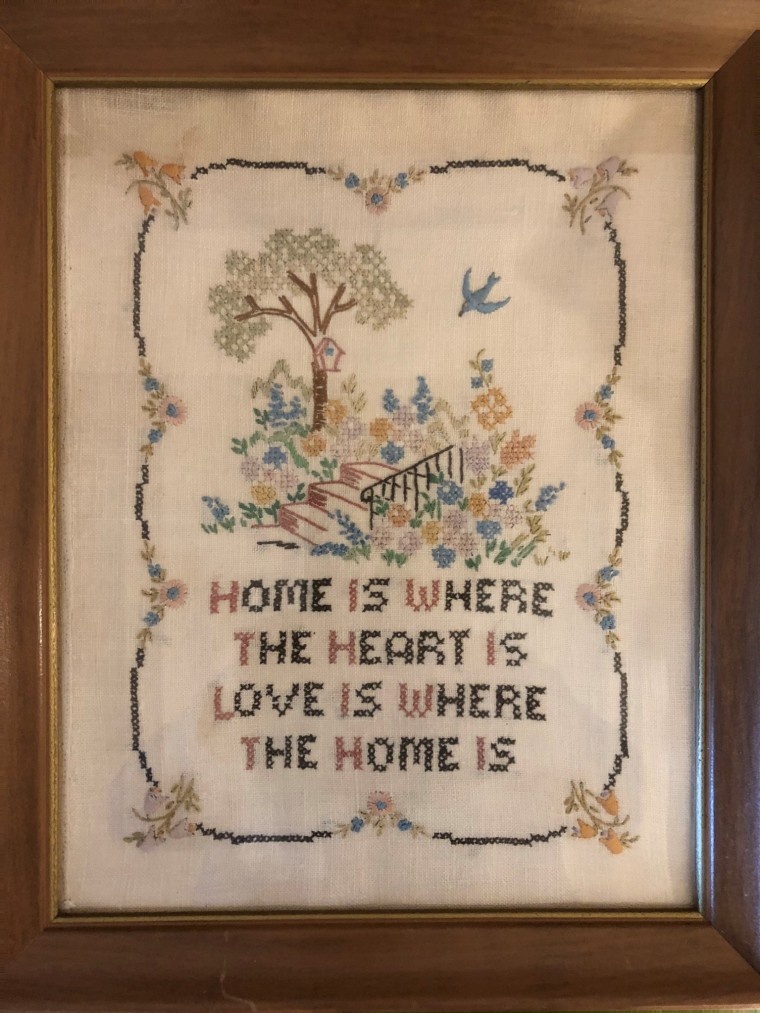
As for the remaining statements, Grandpa’s theory about the origin of the Zieliński surname is pretty much in line with accepted etymology in that the surname derives in some form from the Polish word for “green.” The lack of (close) living relatives from Poland which Grandma mentioned was always a disappointment to me, but ultimately I’ve been able to connect with distant cousins there who were identified through deeper research. The “enclosed pictures” which she mentioned were unfortunately separated from this letter, although I’m certain that my mother still has them, somewhere. And finally, the comment about Grandpa’s family trip back to Poland in 1921 has since been well documented, and I was even able to discover the reason for the trip—the death of the last surviving Zieliński sibling in Poland, Władysław, who died on 23 March 1921, leaving their elderly mother alone to manage the family farm.
So now we’ve come full circle. The family history stories that Grandma recorded in her letter got me started on my path to discover the past, but they are no longer my only source of information. After years of research, I understand which parts of the stories are accurate and which are not, and I even had the opportunity to share with Grandma some of my findings about her family before she passed in 2015. I’m now nearly the age that Grandma was when she wrote that letter, and I’ve taken on her role of story teller, helping a new generation to know a bit about our family’s origins, identifying the patriarchs and matriarchs whose DNA we carry. I only hope that my stories may be as inspirational as hers.
Source:
[1] Helen Zazycki Zielinski, North Tonawanda, New York, to the Roberts family, Cincinnati, Ohio, letter, 4 December 1977, privately held by Julie Szczepankiewicz, Hopkinton, Massachusetts.
© Julie Roberts Szczepankiewicz 2020


What a wonderful story to read on a Friday night after a long week! Thank you, and stay safe – Denise
LikeLiked by 2 people
Thanks so much, Denise! I’m glad you enjoyed it. Have a great weekend, and stay well.
LikeLiked by 1 person
Thanks, Julie! I always enjoy reading your stories. Like you, I’ve been able to corroborate some of my family stories, and find some documentation to support them. Motivates me to keep going!
LikeLiked by 2 people
Thanks for your comments, Kathleen, it’s always nice to connect with other family historians! Good luck with your research as you continue to document your own family stories. Genealogy research can be a real sanity-saver in these present house-bound days. 🙂
LikeLiked by 1 person
What a wonderful find!!
LikeLiked by 1 person
Thanks for the next chapter in this continuing saga of “family”. I am sure there may be many more treasures that you will find among the precious items in your family’s possessions. Uncle Fred
LikeLiked by 2 people
You’re welcome, Uncle Fred! There’s quite a bit to go through, but I’m sure we’ll get there eventually. Thanks so much for all your love and support. Stay safe and well!
LikeLike
Julie, I’ve been reading your blogs and I wanted to share this with you. This is the family of my husband’s GG-Aunt Stella Pasiak and her husband Joseph Green in the 1915 NYS Census. They were living at 103 North 8th Street in Brooklyn, NY. , (AD 14 ED 13)
But wait, there is something amiss. Can you guess it already? Their last name isn’t Green. It’s Zielinski!
All credit goes out to my husband’s sharp-eyed cousin for finding this. Now that I have seen this, I did find another family listed under a name that wasn’t their actual last name.
It’s unknown where this Joseph Zielinski was born in Poland, but I will uncover that at some point.
I enjoy your blogs and really enjoy your webinar. I hope to be able to attend more!
Thanks, Cynthia Schmidt Zalondek
>
LikeLiked by 2 people
Hi Cynthia! Thanks so much for your comments. I’m glad you enjoy the blog and enjoyed the webinar as well. Well done with the discovery that your husband’s “Green” relatives were really Zieliński! Although many of our ancestors altered the spelling of their Polish surnames in their efforts to assimilate into American culture, some of them chose to translate instead. So occasionally one will find a Kwiatkowski who became Bloom, a Szczepankiewicz who became Stephenson, or a Kowalski who became Smith. I wish you continued success with your research as you trace those “Green” and Pasiak roots back to Poland.
LikeLike
You are a wonderful story tellers. I love hearing your tales and wish I had your talent & perseverance.
LikeLiked by 2 people
Thank you for your kind words, Chris! Genealogy is my passion, and blogging is a way to share the stories with people whose eyes don’t glaze over when I start to tell them! 😉
LikeLike
I laughed on reading your first line! Genealogy gold indeed.
My mother also tells me she’s “not interested in history” and “doesn’t want to talk about the past,” and then, every so often, she gets into a reflective mood and talks about the family past! Since it’s always on the phone, I put her on speaker, mute my side of things, and type as she’s talking. Verbatim transcripts are the best.
I really love how you did this piece: grandma’s statement, then your fact check, and always respectfully and with humour. Your family is lucky to have you.
LikeLiked by 2 people
Thank you so much, Linda! I really appreciate your kind remarks.
LikeLike
Beautifully written
LikeLiked by 1 person
Thank you!
LikeLike
Mah pleasure XD
LikeLiked by 1 person